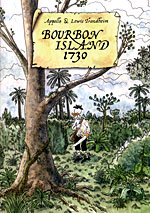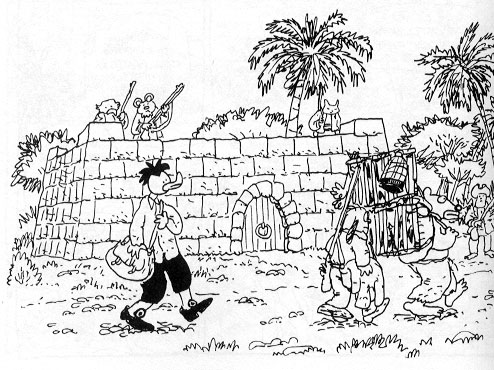 Written by Appollo and Lewis Trondheim
Written by Appollo and Lewis Trondheim
Art by Lewis Trondheim
288 pages, black and white
Published by First Second Books
When is a pirate book not a pirate book? Appollo and Lewis Trondheim’s Bourbon Island 1730 perhaps fulfills the answer to that rhetorical question, set on the Indian Ocean of Bourbon Island (present-day Réunion) as the age of pirates is slowly coming to an end. It’s a combination of adventure and historical fiction showing off the social interactions of the island, but I’m not entirely convinced that the book entirely succeeds on either front.
Raphael and Mr. Despentes are ornithologists, traveling to Bourbon Island to investigate the rumors that the dodo—brought to extinction by settlers in neighboring Mauritius several decades earlier—may still live on this other island. But while Raphael is excited to travel to an island where pirates still sail and adventure, the reality is nothing like he expected. Colonialism is slowly taking control of Bourbon Island over that of the pirates, and high tensions seem poised to tear the island apart as sides slowly begin to form, with the outcast groups of maroons (those who have fled society and formed their own in the wilderness) caught in the middle.
 I’m still not entirely sure if Bourbon Island 1730 is supposed to serve more as adventure, or historical set piece. Appollo and Trondheim don’t seem sure themselves, with the book jumping from one set of characters to the next and providing conflicting messages. The hunt for the dodo itself is certainly little more than a MacGuffin to bring two outsiders onto Bourbon Island itself (those familiar with the extinction of the dodo will know that no dodos were ever found outside of Mauritius; modern scientists believe the reports of dodos were actually sightings of the also-extinct Réunion sacred ibis), and it’s certainly an inventive way to bring characters from Europe all the way to east of southern Africa. Once they’re there, though, the lack of focus seems to keep anything from developing to its full potential. Characters and situations are discarded left and right, and the conclusion of the book comes across so abruptly that it’s a little disconcerting. It feels like things were still building to a head when Appollo and Trondheim lose interest in the entire story, sending our characters back off to sea and the story over. It’s a disappointing end to what feels like it should have been the first in a series of books that continue to follow the inhabitants of Bourbon Island as it goes through its political shifts.
I’m still not entirely sure if Bourbon Island 1730 is supposed to serve more as adventure, or historical set piece. Appollo and Trondheim don’t seem sure themselves, with the book jumping from one set of characters to the next and providing conflicting messages. The hunt for the dodo itself is certainly little more than a MacGuffin to bring two outsiders onto Bourbon Island itself (those familiar with the extinction of the dodo will know that no dodos were ever found outside of Mauritius; modern scientists believe the reports of dodos were actually sightings of the also-extinct Réunion sacred ibis), and it’s certainly an inventive way to bring characters from Europe all the way to east of southern Africa. Once they’re there, though, the lack of focus seems to keep anything from developing to its full potential. Characters and situations are discarded left and right, and the conclusion of the book comes across so abruptly that it’s a little disconcerting. It feels like things were still building to a head when Appollo and Trondheim lose interest in the entire story, sending our characters back off to sea and the story over. It’s a disappointing end to what feels like it should have been the first in a series of books that continue to follow the inhabitants of Bourbon Island as it goes through its political shifts.
 Trondheim’s art is good, but also a little more uneven than I’m used to from him. In his trademark style, characters have different animal heads instead of human features, and Trondheim does a good job of making them look as cute or menacing as he needs. A lot of the early pages, though, are lacking any sort of black fills (aside from Raphael’s head and clothes), making the art feel unfinished and sketchy. It’s actually hard to pick out what’s going on in those pages, especially once the action moves deep into Bourbon Island’s jungles. Thankfully the later sections of the book seem better designed for black and white publication, using fills to help characters and objects pop out of the page. Trondheim is at his best here when it comes to drawing the towns and buildings of Bourbon Island; it certainly feels like he’s done his research, plunging the reader almost 300 years into the past with old colonial style constructions. Not seeing Trondheim draw more of that sort of thing is one of the greatest losses, I think, for there not being another volume around the corner picking up where Bourbon Island 1730 leaves off.
Trondheim’s art is good, but also a little more uneven than I’m used to from him. In his trademark style, characters have different animal heads instead of human features, and Trondheim does a good job of making them look as cute or menacing as he needs. A lot of the early pages, though, are lacking any sort of black fills (aside from Raphael’s head and clothes), making the art feel unfinished and sketchy. It’s actually hard to pick out what’s going on in those pages, especially once the action moves deep into Bourbon Island’s jungles. Thankfully the later sections of the book seem better designed for black and white publication, using fills to help characters and objects pop out of the page. Trondheim is at his best here when it comes to drawing the towns and buildings of Bourbon Island; it certainly feels like he’s done his research, plunging the reader almost 300 years into the past with old colonial style constructions. Not seeing Trondheim draw more of that sort of thing is one of the greatest losses, I think, for there not being another volume around the corner picking up where Bourbon Island 1730 leaves off.
Bourbon Island 1730 isn’t a bad book, but I think it doesn’t quite live up to its potential. At the end of the day, it’s a good book that felt like it should have been a great book. Books that Trondheim works on are normally the latter, and I think it ends up being a real disappointment to not hit its normal high marks. If you go in with lower expectations, you’ll probably be pleased with the end result.
Purchase Links: Amazon.com | Powell’s Books
